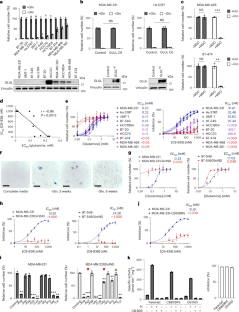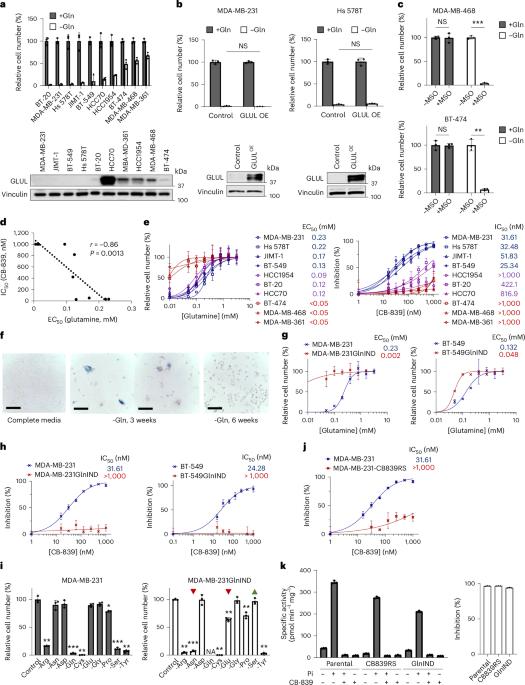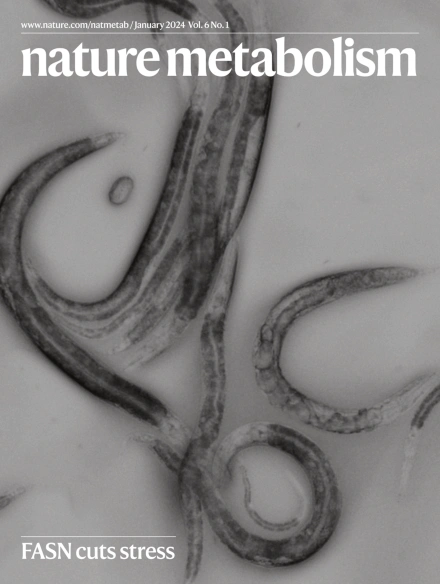PSAT1 的独特催化特性介导了对谷氨酰胺封锁的代谢适应。
IF 18.9
1区 医学
Q1 ENDOCRINOLOGY & METABOLISM
引用次数: 0
摘要
培养的癌细胞经常依赖谷氨酰胺的消耗以及随后谷氨酰胺酶(GLS)的水解。然而,这种代谢成瘾会在肿瘤微环境中消失,从而使 GLS 抑制剂在临床上失效。在这里,我们展示了谷氨酰胺成瘾的乳腺癌细胞通过 AMPK 介导的丝氨酸合成途径(SSP)上调来适应慢性谷氨酰胺饥饿或 GLS 抑制。在这种情况下,SSP 的关键产物不是丝氨酸,而是α-酮戊二酸(α-KG)。从机理上讲,我们发现磷酸丝氨酸氨基转移酶 1(PSAT1)具有独特的能力,能在谷氨酸耗竭时持续产生α-KG。对谷氨酰胺饥饿或 GLS 抑制具有抵抗力的乳腺癌细胞高度依赖 SSP 提供的 α-KG。因此,抑制 SSP 可以阻止对谷氨酰胺阻断的适应,从而产生抑制乳腺肿瘤生长的强效药物协同作用。这些发现突显了代谢冗余是如何依赖于环境的,作用于相同底物的不同代谢酶的催化特性决定了哪些途径可以支持肿瘤在特定营养环境中的生长。这反过来又对针对癌症代谢的疗法产生了实际影响。本文章由计算机程序翻译,如有差异,请以英文原文为准。


The unique catalytic properties of PSAT1 mediate metabolic adaptation to glutamine blockade
Cultured cancer cells frequently rely on the consumption of glutamine and its subsequent hydrolysis by glutaminase (GLS). However, this metabolic addiction can be lost in the tumour microenvironment, rendering GLS inhibitors ineffective in the clinic. Here we show that glutamine-addicted breast cancer cells adapt to chronic glutamine starvation, or GLS inhibition, via AMPK-mediated upregulation of the serine synthesis pathway (SSP). In this context, the key product of the SSP is not serine, but α-ketoglutarate (α-KG). Mechanistically, we find that phosphoserine aminotransferase 1 (PSAT1) has a unique capacity for sustained α-KG production when glutamate is depleted. Breast cancer cells with resistance to glutamine starvation or GLS inhibition are highly dependent on SSP-supplied α-KG. Accordingly, inhibition of the SSP prevents adaptation to glutamine blockade, resulting in a potent drug synergism that suppresses breast tumour growth. These findings highlight how metabolic redundancy can be context dependent, with the catalytic properties of different metabolic enzymes that act on the same substrate determining which pathways can support tumour growth in a particular nutrient environment. This, in turn, has practical consequences for therapies targeting cancer metabolism. Qiu et al. provide insight into the metabolic adaptations that enable breast cancer cells to proliferate in the face of glutaminolysis blockade.
求助全文
通过发布文献求助,成功后即可免费获取论文全文。
去求助
来源期刊

Nature metabolism
ENDOCRINOLOGY & METABOLISM-
CiteScore
27.50
自引率
2.40%
发文量
170
期刊介绍:
Nature Metabolism is a peer-reviewed scientific journal that covers a broad range of topics in metabolism research. It aims to advance the understanding of metabolic and homeostatic processes at a cellular and physiological level. The journal publishes research from various fields, including fundamental cell biology, basic biomedical and translational research, and integrative physiology. It focuses on how cellular metabolism affects cellular function, the physiology and homeostasis of organs and tissues, and the regulation of organismal energy homeostasis. It also investigates the molecular pathophysiology of metabolic diseases such as diabetes and obesity, as well as their treatment. Nature Metabolism follows the standards of other Nature-branded journals, with a dedicated team of professional editors, rigorous peer-review process, high standards of copy-editing and production, swift publication, and editorial independence. The journal has a high impact factor, has a certain influence in the international area, and is deeply concerned and cited by the majority of scholars.
 求助内容:
求助内容: 应助结果提醒方式:
应助结果提醒方式:


